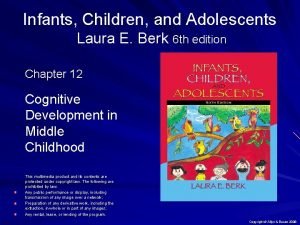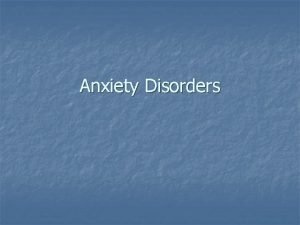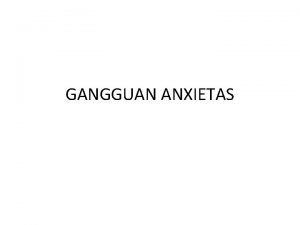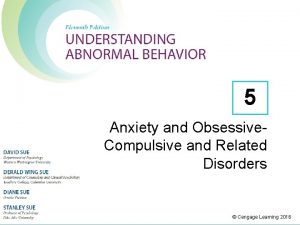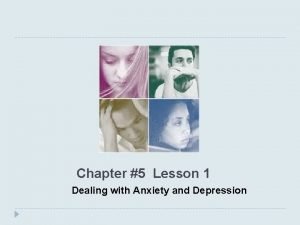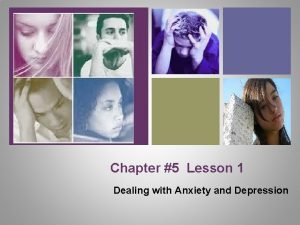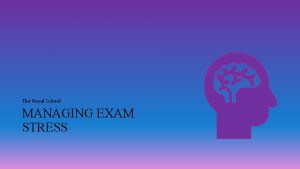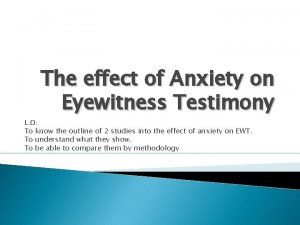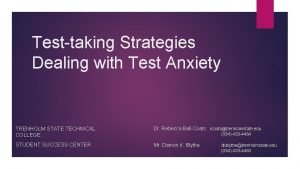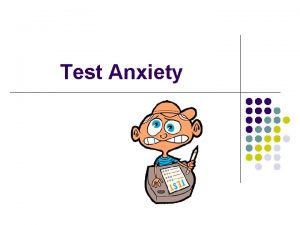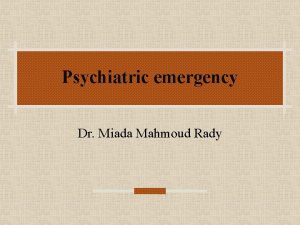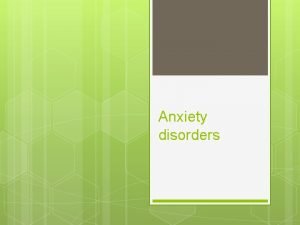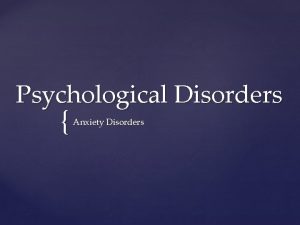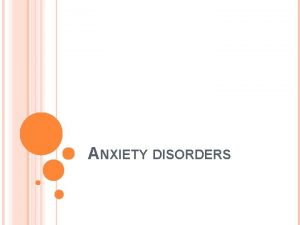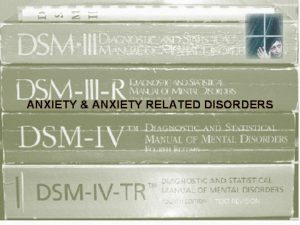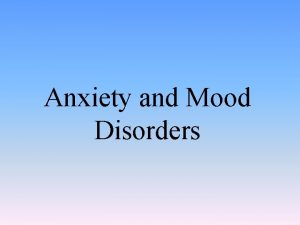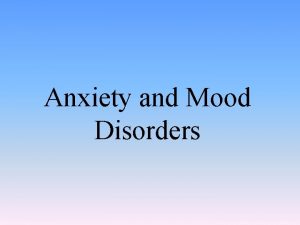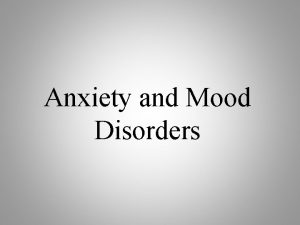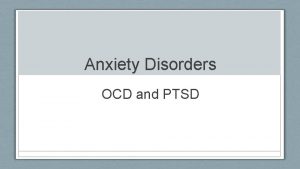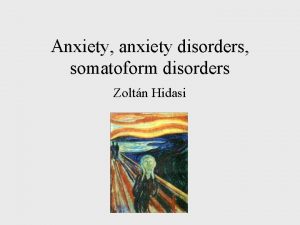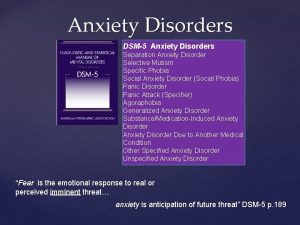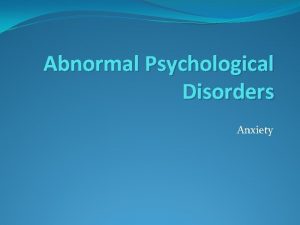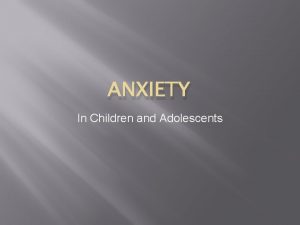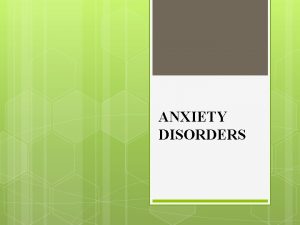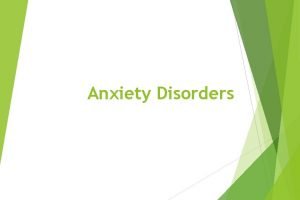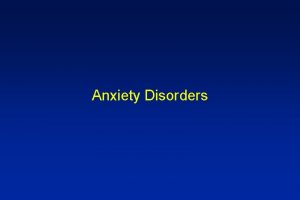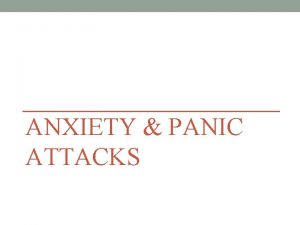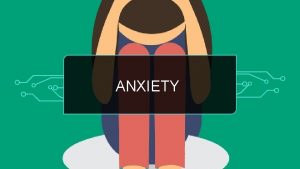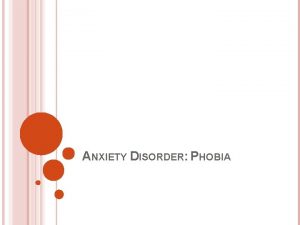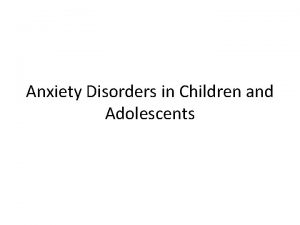Anxiety Disorders Among Children And Adolescents Living With


























- Slides: 26

Anxiety Disorders Among Children And Adolescents Living With HIV: Prevalence, Risk Factors And Impact On Negative Outcomes In The Chaka Project Noeline Nakasujja; MBCh. B. Mmed. Psych, Ph. D Head, Dept of Psychiatry, School of Medicine College of Health Sciences, Makerere University

CHAKA CHildren and Adolescents in KAmpala and Masaka, Uganda (CHAKA) PI –Eugene Kinyanda Mental Health Project, MRC/UVRI Uganda Research Unit on AIDS/ MRC -DFID African Leadership Award 2

CHAKA General Objective To understand psychiatric disorders and neuro-cognitive disorder among children and adolescents with HIV (CA -HIV) in Uganda 3

Outline of the Presentation: Background Objectives Methodology Results Discussion Limitations 4

Why HIV, anxiety and children? 5

Children (<15 years) estimated to be living with HIV 2014 North America and Western and Central Europe Eastern Europe & Central Asia 3300 Caribbean 13 000 [11 000 – 15 000] Latin America 33 000 17 000 [14 000 – 19 000] [2200 – 4700] Middle East & North Africa [29 000 – 40 000] 13 000 [10 000 – 16 000] Asia and the Pacific 200 000 Sub-Saharan Africa [180 000– 230 000] 2. 3 million [2. 2 million – 2. 5 million] Total: 2. 6 million [2. 4 million – 2. 8 million]

Background Globally, 2. 1 million children and adolescent are living with HIV 80% in sub-Saharan Africa (UNAIDS, 2015) Uganda children and adolescents with HIV: 150, 000 (UNAIDS, 2012) Access to effective ART ensuring survival of perinatally infected children into adolescence and adulthood (Louw et al, 2016) These HIV infected children and adolescents (CA-HIV) are at risk of emotional and behavioural problems (Louw et al, 2016) 7

Pre-ART era, children < 15 years, 51% had significant psychological distress (SRQ-25; ≥ 6) (Musisi & Kinyanda, 2009) Adolescents aged 6 -18 years, at least one psychiatric disorder 48. 8%on the MINI KID (Kamau et al, 2012) USA & Puerto Rico, youth aged 6 -17 years, symptom and impairment criteria of the CASI-4 R, at least one PD, 17% (Gadow et al, 2010, Nachman et al, 2012)) 8

• HIV + adolescents (6 -18 years) in Kenya, PD by Mini-Kid: MDD 17. 8%, social phobia 12. 8%, specific phobia 7. 1%, panic disorders 5. 8%, agoraphobia 2. 6%, separation anxiety disorder 2. 6% (Kamau et al, 2012) Diagnostic Interview Schedule for Children (DISC-IV), anxiety disorders 49%, Mood disorders 7. 3% (Mellin et al, 2009) 9

Objectives: To describe the prevalence of anxiety disorders and its predictors among CAHIV To describe the risk factors for anxiety disorders among CA-HIV in the Chaka Project 10

Methodology CHAKA cohort of 1, 336 children/adolescentcaregiver dyads with HIV recruited at 4 HIV care facilities (2 urban, 2 rural) The AIDS Support Organisation clinic and The Uganda Cares clinic Joint Clinical Research Centre, clinic and Nsambya Homecare Department In this study, Children defined as 5 -11 years, Adolescents as being 12 -17 years Assessments undertaken by trained psychiatric nurses & Psychiatric Clinical Officers 11

Anxiety assessment: Anxiety disorders: generalised anxiety disorder, specific phobia, panic attack, somatic symptom disorder, social anxiety disorder (social phobia), separation anxiety disorder 12

Psychiatric Assessments Child and adolescent psychiatric disorder • Child & Adolescent Symptom Inventory-5 (CASI-5 (caregiver) • Youth Self Report Symptom Inventory-4 (8 -11 yrs) • Youth Inventory 4 R (12 -17 yrs)

Psychosocial factors: Life time trauma events (A) • 2 questions, 1 physical trauma, 1 sexual trauma Negative life events (last 6 months) (A) • 2 questions, parents separated, parents very ill HIV felt stigma (last 12 month) (A) • Using the Brief HIV Stigma Scale-5 items Child-caregiver relationship (asked caregiver) (CA). Using the Child-Caregiver Relationship Inventory

Biological & Clinical factors: Wong-Baker faces (Pain) (C & A) Worst HIV clinical stage ever attained (C & A) Current HIV clinical symptoms (WHO pediatric clinical staging (child) Current HIV clinical symptoms (WHO clinical staging) (adolescent) CD 4 nadir (C & A) Current CD 4 count (baseline, 6 months, 12 months) (C & A)

Statistical Methods Considered items that occur “often” or “very-often” - used for prevalence Problem deemed clinically significant if it interferes with functioning “often” or “very often” Score for each problem 0 (never) to 3 (very often) – used for alternative risk factor analysis to increase power

Statistical Methods Bivariate analyses for associations between socio-demographic factors, vulnerability factors and stress factors Multivariable logistic regression model fitted based on stress vulnerability model to choose relevant predictors (backward elimination)

Demographic characteristics Variable Study Site Sex Age group Religion Tribe Child lives with Level Anxiety disorders (n=284) n (%) Urban (n=684) 154 (22. 5%) Rural (n=655) 130 (19. 9%) Male (n=638) 130 (20. 4%) Female (n=699) 154 (22. 0%) Children (n=855) 204 (23. 9%) Adolescents (n=484) 80 (16. 5%) Christian (n=1058) 218 (20. 6%) Muslim (n=273) 65 (23. 8%) Others/missing (n=8) 1 (12. 5%) Baganda (n=967) 212 (21. 9%) Non-Baganda (n=370) 72 (19. 5%) Both parent (n=354) 94 (26. 6%) Mother only (n=417) 86 (20. 6%) Father only (n=95) 15 (15. 8%) Grandparents (n=258) 47 (18. 2%) 42 (19. 5%) Test Statistic (P-value) Χ 2 = 1. 42 (P=0. 23) Χ 2 = 0. 55 (P=0. 46) Χ 2 = 9. 94 (P=0. 002) Χ 2 = 1. 70 (P=0. 43) Χ 2 = 0. 97 (P=0. 32) Χ 2 = 9. 55 (P=0. 05) 18

Family Structure Variable Level Mother of child alive Yes (n=948) No/do not know (n=391) Father of child alive Yes (n=960) No/do not know (n=379) Born premature Yes (n=20) No/do not know (n=835) Child attending Yes (n=30) special education No (n=1274) Family has enough Yes (n=660) food No (n=191) Socio-economic Disorder (n=204) Anxiety disorders (n=284) n (%) 217 (22. 9%) 67 (17. 1%) Test Statistic (Pvalue) Χ 2 = 5. 49 (P=0. 02) 217 (22. 6%) 67 (17. 7%) Χ 2 = 3. 95 (P=0. 05) 7 (35. 0%) 197 (23. 6%) Χ 2 = 1. 40 (P=0. 24) 8 (26. 7%) 273 (21. 4%) 153 (23. 2%) 51 (26. 7%) 4. 48 (1. 8) Χ 2 = 3. 47 (P=0. 18) Χ 2 = 1. 01 (P=0. 32) F=4. 70 19

Factor Viral load (copies/m. L) HIV felt stigma Level (N=899) Anxiety disorders (n=284) n (%) <1000 -9999 ≥ 10, 000 none (n=1240) some-1 and above (n=99) 190 (23. 8%) 16 (18. 2%) 40 (20. 5%) 272 (21. 9%) 12 (12. 1%) Test Statistic (P-value) Χ 2 = 2. 11 (P=0. 35) Χ 2 = 5. 28 (P=0. 02) 20

Pattern and prevalence of anxiety disorders Psychiatric Disorder (n=1337) Any anxiety disorder Generalized Anxiety Disorder Specific Phobia Panic Disorder Post-traumatic stress disorder Social Anxiety Meet symptom criteria only n (%) Impairing psychiatric symptoms n (%) Meet criteria for DSM-5 n (%) 284 (21. 2%) 22 (1. 6%) 54 (4. 0%) 10 (0. 8%) 56 (4. 2%) 11 (0. 8%) 191 (14. 3%) 36 (2. 7%) 64 (4. 8%) 37 (2. 8%) 21

Pattern and prevalence of anxiety disorders 25 20 15 10 5 0 Generalized anxiety disorder Specific Phobia Panic disorder Post Traumatic Steress disorder Social Anxiety Seperation Anxiety Disorder 22

Logistic model for factors associated with anxiety Factor Level a. OR Sex of child Male Female Per 5 year increase No formal Primary Secondary Higher No Yes 1 1. 19 0. 80 95% Confidence Limits Reference (0. 90 ; 1. 57) (0. 64 ; 0. 996) 0. 66 1 0. 99 1. 04 1 1. 95 (0. 39 ; 1. 14) Reference (0. 72 ; 1. 35) (0. 65 ; 1. 66) Reference (1. 43 ; 2. 67) No Yes 1 2. 05 1 3. 04 Reference (1. 26 ; 3. 34) Reference (1. 80 ; 5. 14) Age of child Caregiver Education level Caregiver positive on selfreport qu’re Child has any depression Child has othe PD e. g ADHD, ODD Likelihood Ratio P-value 0. 22 0. 046 0. 50 <0. 001 0. 004 <0. 001 23

Discussion • Caregiver depression & psychological distre • (Louw et al, 2016; Lentoor et al, 2016; Betancourt et al, 2015) • HIV stigma (Dow et al, 2016) • Low socio-economic status (Betancourt et al, 2015) • Non epidemiologic sample • Quality of care hypothesis (Lund et al 2010) 24

Summary of Findings: 21. 2 % prevalence of any anxiety disorder Risk factors included : young age, living with distressed caregiver Quality of care hypothesis

Acknowledgments Jonathan Levin Richard Mpango Soraya Seedat, Tatiana Salisbary Catherine Abbo Vikram Patel Kinyanda Eugene 26
 Infants, children and adolescents 8th edition
Infants, children and adolescents 8th edition Infants, children, and adolescents 8th edition
Infants, children, and adolescents 8th edition Chapter 15 anxiety and obsessive-compulsive disorders
Chapter 15 anxiety and obsessive-compulsive disorders Anxiety disorders def
Anxiety disorders def Gangguan cemas icd 10
Gangguan cemas icd 10 Multipath model of anxiety disorders
Multipath model of anxiety disorders Difference between dating and courting
Difference between dating and courting Joshua 3 10
Joshua 3 10 Types of living organisms
Types of living organisms Interactions among living things
Interactions among living things Blue things
Blue things Tomato living or nonliving
Tomato living or nonliving Living non living dead
Living non living dead What is the smallest living unit of life
What is the smallest living unit of life Chapter 8 managing stress and anxiety
Chapter 8 managing stress and anxiety Frustration anxiety and tension
Frustration anxiety and tension Chapter 5 lesson 1 dealing with anxiety and depression
Chapter 5 lesson 1 dealing with anxiety and depression Chapter 5 lesson 1 dealing with anxiety and depression
Chapter 5 lesson 1 dealing with anxiety and depression Cpi model
Cpi model Anxiety symptoms
Anxiety symptoms Igor areh
Igor areh Relaxation techniques test anxiety
Relaxation techniques test anxiety Test taking anxiety symptoms
Test taking anxiety symptoms I'm a perfect example of someone who has math anxiety
I'm a perfect example of someone who has math anxiety Neurotic behavior
Neurotic behavior Define neurotic
Define neurotic Nursing interventions for ineffective coping
Nursing interventions for ineffective coping

